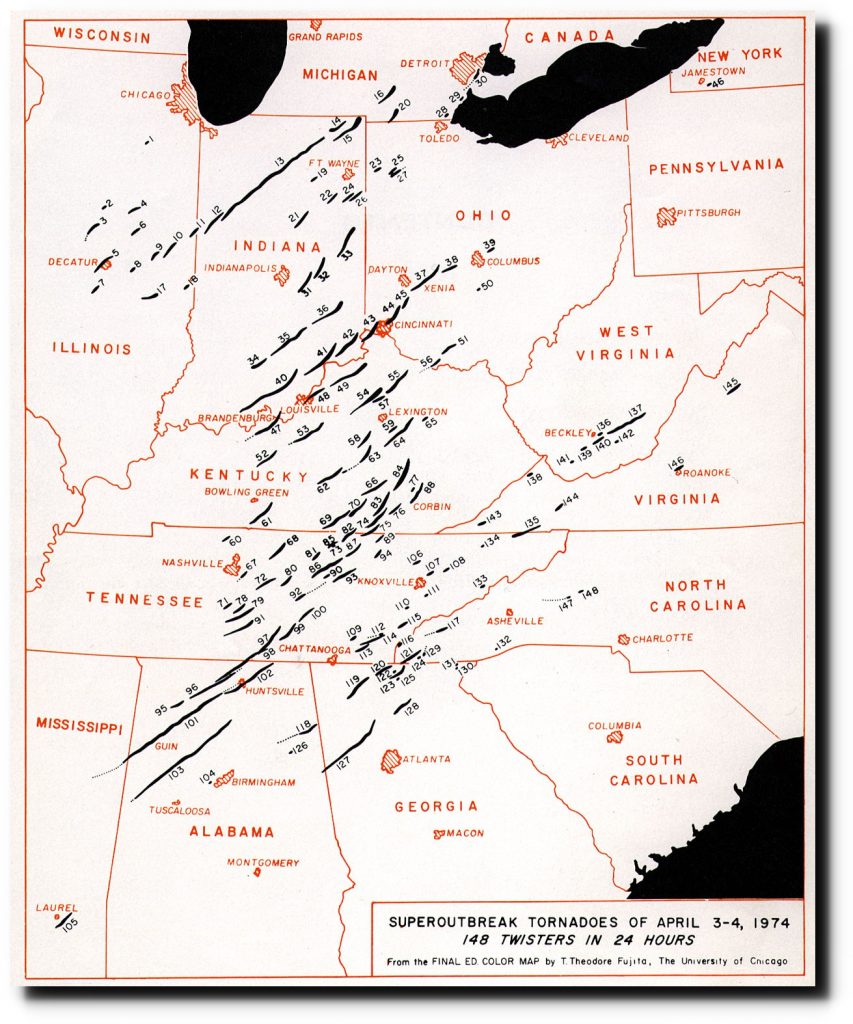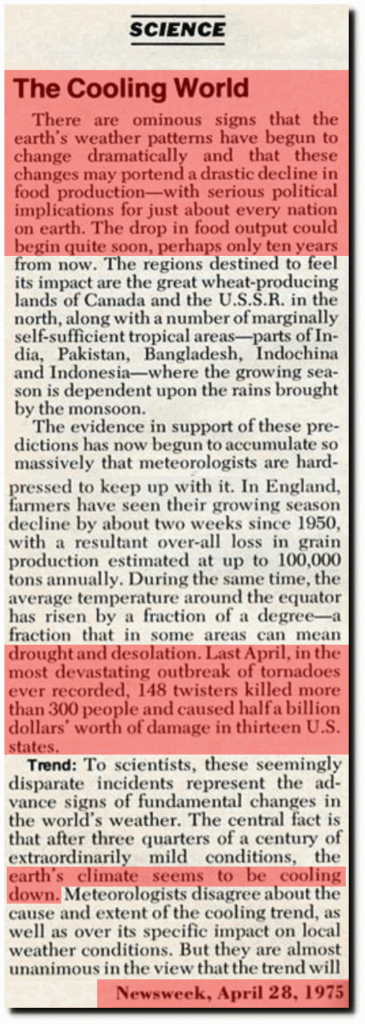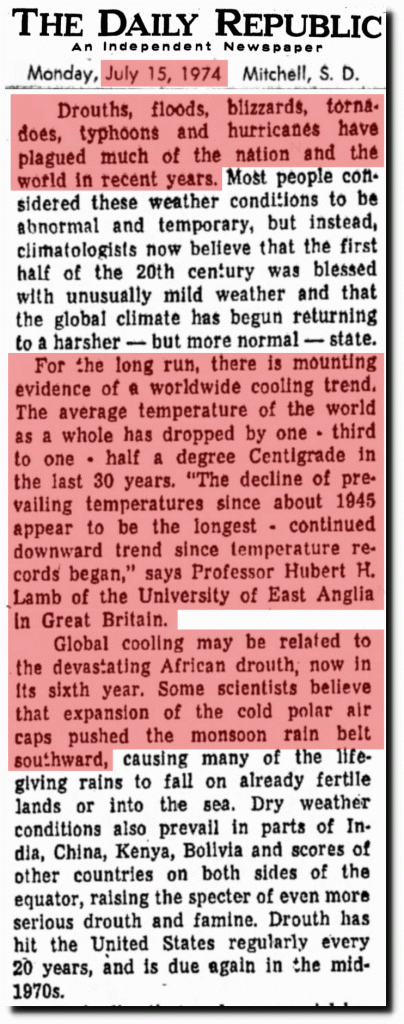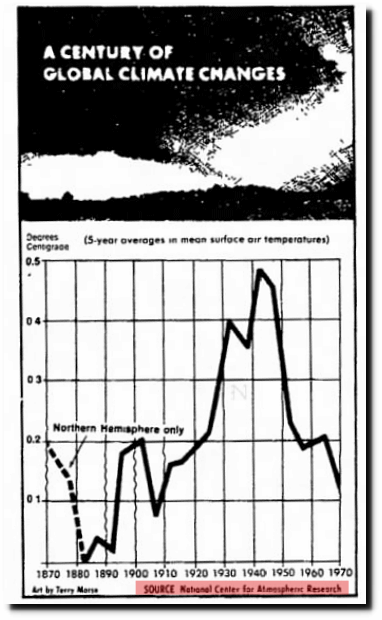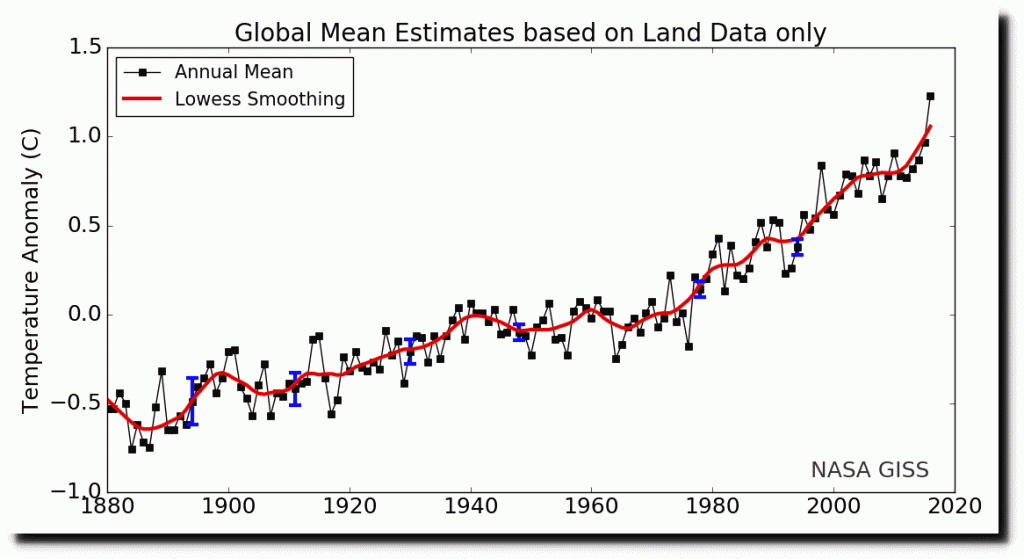‘Fraud, Fake…Worthless Words’: NASA’s James Hansen on UN Paris Pact – Trump should take note
By Robert Bradley Jr. — May 9, 2017
“Watch what happens in Paris carefully to see if all that the leaders do is sign off on the pap that UN bureaucrats are putting together, indulgences and promises to reduce future emissions, and then clap each other on the back and declare success.”
“Big Green consists of several ‘environmental’ organizations, including Environmental Defense Fund (EDF) and National Resources Defense Council (NRDC), each with $100+M budgets, each springing from high-minded useful beginnings, each with more high-priced lawyers than you can shake a stick at. EDF …was chief architect of the disastrous Kyoto lemon. NRDC proudly claims credit for Obama’s EPA strategy and foolishly allows it to migrate to Paris.”
– James Hansen, “Isolation of 1600 Pennsylvania Avenue: Part I,” November 27, 2015.
“[The Paris agreement] is a fraud really, a fake. It’s just bullshit for them to say: ‘We’ll have a 2C warming target and then try to do a little better every five years.’ It’s just worthless words. There is no action, just promises. As long as fossil fuels appear to be the cheapest fuels out there, they will be continued to be burned.”
– James Hansen, quoted in Oliver Milman, “James Hansen, Father of Climate Change Awareness, Calls Paris ‘A Fraud’.” The Guardian, December 12, 2015.
James Hansen has weighted in the Paris agreement, which is now on the firing line with the U.S. threating to set into motion a pullout. Hansen’s disfavor of this global climate agreement, setting voluntary targets for greenhouse gas reductions globally, might rival that of President Trump, but for contrary reasons.
The good news is that the father of climate alarmism has repeatedly spoken truth to power when it comes to the politics of energy and climate.
Oh No! Global warming will cause increase in exercise — But exercise increases global warming!
Flashback 2007: Exercise Causes Global Warming – Walking to the Shops ‘Damages Planet More Than Going By Car’
By Noel Sheppard | August 8, 2007 – Newsbusters

As reported by the Times Online Saturday in a piece hysterically titled “Walking to the Shops ‘Damages Planet More Than Going By Car'” (grateful h/ts to all NBers and readers who forwarded this article for consideration, emphasis added throughout):
Walking does more than driving to cause global warming, a leading environmentalist has calculated.
Food production is now so energy-intensive that more carbon is emitted providing a person with enough calories to walk to the shops than a car would emit over the same distance. The climate could benefit if people avoided exercise, ate less and became couch potatoes. Provided, of course, they remembered to switch off the TV rather than leaving it on standby.
Absolutely amazing. But there was more:
The sums were done by Chris Goodall, campaigning author of How to Live a Low-Carbon Life, based on the greenhouse gases created by intensive beef production. “Driving a typical UK car for 3 miles [4.8km] adds about 0.9 kg [2lb] of CO2 to the atmosphere,” he said, a calculation based on the Government’s official fuel emission figures. “If you walked instead, it would use about 180 calories. You’d need about 100g of beef to replace those calories, resulting in 3.6kg of emissions, or four times as much as driving.
“The troubling fact is that taking a lot of exercise and then eating a bit more food is not good for the global atmosphere. Eating less and driving to save energy would be better.”
Now, just imagine where this insanity could go:
- Gymnasiums and athletic clubs closed to slow global warming
- Jogging made illegal to slow global warming
- Golf banned to slow global warming
- All organized sporting events including amateur, collegiate and professional banned to slow global warming.
Is it becoming obvious the amount of control environmentalists seek over personal behavior all in the name of global warming?…
‘March for Science’: Politics Disguised as Science: When to Doubt a Scientific ‘Consensus’
This week’s March for Science is odd. Marches are usually held to defend something that’s in peril. Does anyone really think big science is in danger? The mere fact that the March was scheduled for Earth Day betrays what the event is really about: politics. The organizers admitted as much early on, though they’re now busy trying to cover the event in sciencey camouflage.
If past is prologue, expect to hear a lot about the supposed “consensus” on catastrophic climate change this week. The purpose of this claim is to shut up skeptical non-scientists.
How should non-scientists respond when told about this consensus? We can’t all study climate science. But since politics often masquerades as science, we need a way to tell one from the other.
“Consensus,” according to Merriam-Webster, means both “general agreement” and “group solidarity in sentiment and belief.” That sums up the problem. Is this consensus based on solid evidence and sound logic, or social pressure and groupthink?
When can you doubt a consensus? Your best bet is to look at the process that produced, defends and transmits the supposed consensus.
Anyone who has studied the history of science knows that scientists are prone to herd instincts. Many false ideas once enjoyed consensus. Indeed, the “power of the paradigm” often blinds scientists to alternatives to their view. Question the paradigm, and some respond with anger.
We shouldn’t, of course, forget the other side of the coin. There are cranks and conspiracy theorists. No matter how well founded a scientific consensus, there’s someone who thinks it’s all hokum. Sometimes these folks turn out to be right. But often, they’re just cranks whose counsel is best ignored.
So how do we distinguish, as Andrew Coyne puts it, “between genuine authority and mere received wisdom? And how do we tell crankish imperviousness to evidence from legitimate skepticism?” Do we have to trust whatever we’re told is based on a scientific consensus unless we can study the science ourselves? When can you doubt a consensus? When should you doubt it?
Your best bet is to look at the process that produced, defends and transmits the supposed consensus. I don’t know of any complete list of signs of suspicion. But here’s a checklist to decide when you can, even should, doubt a scientific “consensus,” whatever the subject.
13 Most Ridiculous Predictions Made on Earth Day, 1970
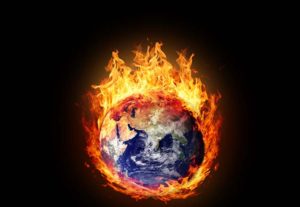 Saturday is Earth Day — an annual event first launched on April 22, 1970. The inaugural festivities (organized in part by then hippie and now convicted murderer Ira Einhorn) predicted death, destruction and disease unless we did exactly as progressives commanded.
Saturday is Earth Day — an annual event first launched on April 22, 1970. The inaugural festivities (organized in part by then hippie and now convicted murderer Ira Einhorn) predicted death, destruction and disease unless we did exactly as progressives commanded.
Sound familiar? Behold the coming apocalypse, as predicted on and around Earth Day, 1970:
- “Civilization will end within 15 or 30 years unless immediate action is taken against problems facing mankind.” — Harvard biologist George Wald
- “We are in an environmental crisis which threatens the survival of this nation, and of the world as a suitable place of human habitation.” — Washington University biologist Barry Commoner
- “Man must stop pollution and conserve his resources, not merely to enhance existence but to save the race from intolerable deterioration and possible extinction.” — New York Times editorial
- “Population will inevitably and completely outstrip whatever small increases in food supplies we make. The death rate will increase until at least 100-200 million people per year will be starving to death during the next ten years.” — Stanford University biologist Paul Ehrlich
- “Most of the people who are going to die in the greatest cataclysm in the history of man have already been born… [By 1975] some experts feel that food shortages will have escalated the present level of world hunger and starvation into famines of unbelievable proportions. Other experts, more optimistic, think the ultimate food-population collision will not occur until the decade of the 1980s.” — Paul Ehrlich
- “It is already too late to avoid mass starvation,” — Denis Hayes, Chief organizer for Earth Day
- “Demographers agree almost unanimously on the following grim timetable: by 1975 widespread famines will begin in India; these will spread by 1990 to include all of India, Pakistan, China and the Near East, Africa. By the year 2000, or conceivably sooner, South and Central America will exist under famine conditions…. By the year 2000, thirty years from now, the entire world, with the exception of Western Europe, North America, and Australia, will be in famine.” — North Texas State University professor Peter Gunter
- “In a decade, urban dwellers will have to wear gas masks to survive air pollution… by 1985 air pollution will have reduced the amount of sunlight reaching earth by one half.” — Life magazine
- “At the present rate of nitrogen buildup, it’s only a
Alarming Arctic heat waves look a lot like the last alarming heat waves in 1940s
Alarming Arctic heat waves look a lot like the last alarming heat waves in 1940s
The Arctic is the most sensitive place to man-made emissions on Earth, which is why it has barely warmed since 1944? Well, it makes sense if CO2 is largely irrelevant. Humans have made 90% of all their CO2 in the last 70 years and nothing much happened in the place where it was supposed to hurt the most. The WMO apparently missed the first 30 years of data. But Dr. Sebastian Lüning and Prof. Fritz Vahrenholt are here to help them out. : -) “Heat waves in the Arctic – climate scientists sound the alarm“ Area weighted Arctic (70-90N) monthly surface air temperature anomalies (HadCRUT4) since 1920 in relation to the WMO normal period 1961-1990. Fig. 2: Arctic temperature since 1920. Data: HadCRUT4, Chart: Climate4You. These heat waves look a lot like the last heat waves. Read it all thanks to Pierre Gosselins translation: Learning from the climate’s history: the Arctic heat waves of the 1930s and 40s Rating: 10.0/10 (1 vote cast)Rating: 10.0/10 (1 vote cast)
— gReader Pro…
Eugenics: When Scientific Consensus Leads To Mass Murder
Eugenics: When Scientific Consensus Leads To Mass Murder
http://www.thegwpf.com/eugenics-when-scientific-consensus-leads-to-mass-murder/
Eugenics, the notion of improving the genetic quality of the human race through selective breeding, is a dark stain upon science’s past. It is a prime example of how science can be misused to support nefarious ends. Eugenics is most commonly associated with Nazi Germany, where poor, mentally ill, blind, deaf, developmentally disabled, promiscuous, homosexual, and Jewish people (among countless other groups) were murdered by the millions in an effort to purify the populace and create a master race. But we must not forget that eugenics also has a prominent legacy in the United States, one which began well before the Nazis sowed their own, much darker history. When scientific research made clear that traits are heritable and passed on from parent to offspring through genes, individuals in society began wondering how these findings could be applied to humans in an effort to improve our species. This notion, originally opined by Sir Francis Galton in the 1860s in the United Kingdom, soon spread to the United States. In the late 19th century and early 20th century, prominent Americans including Alexander Graham Bell, Margaret Sanger, and even Theodore Roosevelt expressed support. By the 1920s, eugenics was a genuine movement. As author and pediatrician Paul Offit describes in his new book, Pandora’s Lab, Hundreds of colleges taught courses on the subject. It appeared in the majority of high school biology textbooks. There were fairs, meetings, and advertisements. The nationwide campaign convinced citizens and legislatures – forty-one states eventually prohibited marriage by those deemed feeble-minded or insane, and a few states even instituted policies of forced sterilization. It was Virginia’s law on forced sterilization that eventually reached the Supreme Court. The case, Buck v. Bell, argued ninety years ago, pitted the Virginia State Colony for Epileptics and Feebleminded against one of its patients, Carrie Buck. The colony’s superintendent, Dr. John Hendren Bell, wanted to sterilize Buck. His lawyers argued that Buck was a “genetic threat” to society. Buck’s lawyer argued that she had a right to procreate which was being violated. The Court sided 8 – 1 with the colony. The majority opinion, penned by the legendary justice Oliver Wendell Holmes, seems like it originated from a dystopian work of science fiction: “We have seen more than once that the public welfare may call upon the best citizens for their lives. It would be strange if it …
Flashback: Major Tornado Outbreak Of April 1974 Blamed on — Global Cooling!
The worst tornado outbreak in recent history occurred on April 3-4, 1974 at the peak of the 1970’s ice age scare.
Temperatures on April 3, were very hot in the southeast with Texas over 100 degrees and much of the south over 90 degrees. Over the next 48 hours a strong cold front pushed across the region and spawned the tornadoes when very cold, dry air collided with the warm humid air in the southeast.
…
Scientists at the time blamed the tornadoes on global cooling, which they said was going to kill us all.
www.denisdutton.com/newsweek_coolingworld.pdf
Tornadoes are now blamed on global warming, which scientists say will kill us all. Biggest scam in science history.
Flashback: ‘Global warming” could lead to 10ft reptiles
Could global warming lead to 10ft reptiles? Scientists say small plant-eating lizards could grow to the size of Komodo dragons
Fossils of a giant lizard discovered in Burma have led scientists to believe a rise in temperature 40 million years ago caused plant-eating lizards to grow to the size of the 10ft dragons.
Scientists previously thought that large meat-eating dragons grew larger than their herbivore cousins because of a lack of predators.
These findings now from from the University of California and University of Nebraska-Lincoln suggest that a warmer climate is needed for large lizards to grow – and that global warming could cause this to happen again.

Fossils discovered by the University of California of the Barbateux Morrisoni, pictured, have led scientists to believe that a rise in temperature 40 million years ago caused plant-eating lizards to grew to the size of the 10ft dragons. They now believe global warming could cause this to happen again
FLASHBACK: NY Times Predicted The ‘End Of Snow’ In 2014
By MICHAEL BASTASCH
Peter Fox, the editor of Powder magazine, suggested “The End Of Snow?” in a February 2014 op-ed. Fox lamented the cancelation of two events at the winter Olympics in Sochi, Russia that year, and noted predictions that some cities would be too warm to even hold the winter games.
“[W]ith a rise in the average global temperature of more than 7 degrees Fahrenheit possible by 2100, there might not be that many snowy regions left in which to hold the Games,” Fox wrote for The NYT.Scientists have measured a general decrease in Northern Hemisphere monthly snow extent since 1966, but that takes into account all 12 months of the year. Though even then, snow extent has increased since the late 1980s.
…
But Northern Hemisphere winter snow extent has increased in that time. Rutgers University’s Global Snow Lab lays it out here:

Source: Rutgers University Global Snow Lab
What’s interesting is Fox wrote his article not long after Winter Storm Jonas left 30 people dead and millions more covered in up to two feet of snow in January. That winter season was one of the coldest on record, according to a meteorologist with AccuWeather.…
Flashback 1974: Global Cooling Caused Droughts, Floods, Blizzards, Tornadoes, Typhoons, Hurricanes & Polar Vortex!
In 1974, everything which is currently blamed on global warming, was blamed on the longest global cooling trend on record: 0.5C cooling since 1945.
15 Jul 1974, Page 3 – The Daily Republic
14 Jul 1974, Page 1 – Lincoln Evening Journal
These was problematic for NASA’s fake climate science, so they simply rewrote the past to eliminate the cooling.

